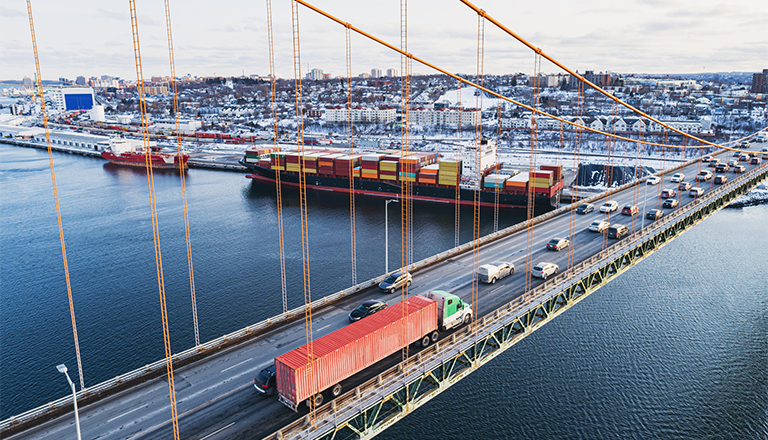Like all of the 11 Incoterms 2020 rules, the four that make up Group C—cost and freight (CFR), cost insurance freight (CIF), carriage paid to (CPT) and cost insurance paid to (CIP)—are designed to eliminate confusion in sales contracts. What these rules have in common is that when they’re used in a contract, the seller is responsible for arranging shipment and paying all costs up to the destination point.
Which Group C terms you use in your export contracts depends on several factors, including:
- the mode of transport for delivering your goods; and
- whether insurance is required to protect the buyer from loss or damage to the goods while they’re en route to their final destination.
Understanding the CFR and CIF rules
If you’re shipping your products by sea or inland waterway, you can use the cost and freight (CFR) or cost insurance freight (CIF) rules in your export contract. These rules are only applicable to goods being shipped in this manner.
The exporter’s responsibilities under CFR include:
- arrange and pay for the carriage of the goods to the agreed destination port;
- deliver the goods and clear them for export;
- load them onto the ship that will be transporting them to the destination port;
- provide the buyer with the documents they need to obtain the goods from the carrier.
The exporter is responsible for the costs of carriage to the destination port. The risk of loss or damage to the goods passes to the buyer as soon as the products are onboard the vessel. With CFR, the exporter isn’t responsible for insuring the goods while they’re in transit to the destination port.
You should also check out
Expand your understanding of the 11 universal trade terms used in global sales contracts and how they impact your business operations.
This is a key difference between CFR and another closely related Group C term: Cost insurance and freight (CIF). The seller has all the same responsibilities as with CFR with one exception: CIF requires the seller to take out marine insurance to protect against the loss, damage or destruction of the goods being shipped.
Under CIF, the lowest level of insurance coverage, which is defined in the institute cargo clauses, is the default. As the exporter, you can still opt for a higher level of coverage if the buyer agrees to it. It’s important to emphasize, that the insurance policy is purchased by the seller, but the beneficiary is the buyer.
Understanding carriage rules
The two remaining Group C rules—carriage paid to (CPT) and carriage and insurance paid to (CIP)—apply to any mode of transport.
Under CPT, the seller must:
- Clear the goods for export
- Deliver the goods to a carrier or another designated person
- Make all the arrangements and pay all freight and other costs required to transport the goods to the agreed destination
Delivery of the goods occurs when you, as the exporter, deliver them to the carrier. This is the point at which the risk transfers from you to the buyer. When multiple carriers are involved, the risk of loss or damage to the goods transfers to the buyer when the goods are delivered to the first carrier. If the goods are being transferred to an alternative delivery point, the buyer must ensure that this is detailed in the contract of sale. CPT doesn’t require the seller to insure the goods being transported, which has the potential to result in risk for the buyer.
To mitigate this risk, the buyer could use the CIP rule instead of CPT. It’s similar to CPT, except the seller has to pay to insure the goods until they reach their destination and pay the freight. The insurance requirement for the CIP rule is one area that has changed with Incoterms 2020. This rule now requires a higher level of coverage compliant with the institute cargo clauses. With this Incoterm, the insurance policy is also issued with the beneficiary being the buyer.
Cargo insurance is different from Export Development Canada’s Credit Insurance. EDC’s covers the risk of non-payment, while cargo insurance covers the losses of the freight.
You should also check out
Keep track of the international markets that matter to your business. Get the latest financial and macroeconomic information for both developed and emerging markets.
This is a key difference between CFR and another closely related Group C term: Cost insurance and freight (CIF). The seller has all the same responsibilities as with CFR with one exception: CIF requires the seller to take out marine insurance to protect against the loss, damage or destruction of the goods being shipped.
Under CIF, the lowest level of insurance coverage, which is defined in the institute cargo clauses, is the default. As the exporter, you can still opt for a higher level of coverage if the buyer agrees to it. It’s important to emphasize, that the insurance policy is purchased by the seller, but the beneficiary is the buyer.
Who’s responsible for the loss?
A Canadian car parts exporter in Ontario is selling to an American buyer. The contract with the buyer includes the term “CPT Dallas, Texas, USA Incoterms 2020.” The seller hires a Canadian trucking company and arranges for it to take the goods to a cross-docking facility in Chicago. A second trucking company, based in the United States and contracted as well by the seller, is scheduled to receive the goods at the facility and then take them to Dallas.
While the goods are inside the cross-docking facility, they’re damaged by a water leak and aren’t loaded onto the U.S. trucking company’s vehicle. The buyer isn’t aware of the involvement of the Canadian trucking company or the cross-docking arrangement, and the sales contract doesn’t mention the transfer in Chicago.
Is the buyer or seller at risk of loss?
In this case, it’s the seller’s loss. Under the CPT rule, the seller pays the cost of carriage necessary to bring the goods to the named destination, delivers the goods and transfers the risk to the buyer by handing them over to the carrier contracted by the seller. But in this example, there are multiple carriers involved, and the buyer and the seller failed to define the place of delivery in the contract.
Normally, the risk would pass to the buyer when the seller has delivered the goods to the first carrier (the Canadian trucking company). But CPT Article A4 states that the seller must contract for the carriage of the goods “at the place of delivery to the named place of destination.” Since the first carrier wasn’t responsible for the carriage of the goods through to the named destination, delivery would only have occurred when the goods were handed over to the U.S.-based trucking company contracted to take the goods to Dallas. Since delivery hadn’t yet occurred when the goods were damaged by the water leak, the seller is liable to the buyer.
For more information about the Group C rules and the other seven Incoterms, see the official Incoterms rule book. The International Chamber of Commerce (ICC) has also created an Incoterms 2020 app, which gives you easy access to a wealth of practical information on your mobile device.
For more information about Incoterms, visit EDC’s Export Help Hub.
Continue series

Part 4 of 4 in series
Incoterms 2020: Understanding the Group D and FOB rules
Continue seriesPart 1 of 4 in series
Incoterms 2020: Understanding the Ex Works rulePart 2 of 4 in series
Incoterms 2020: Understanding the FCA rule






